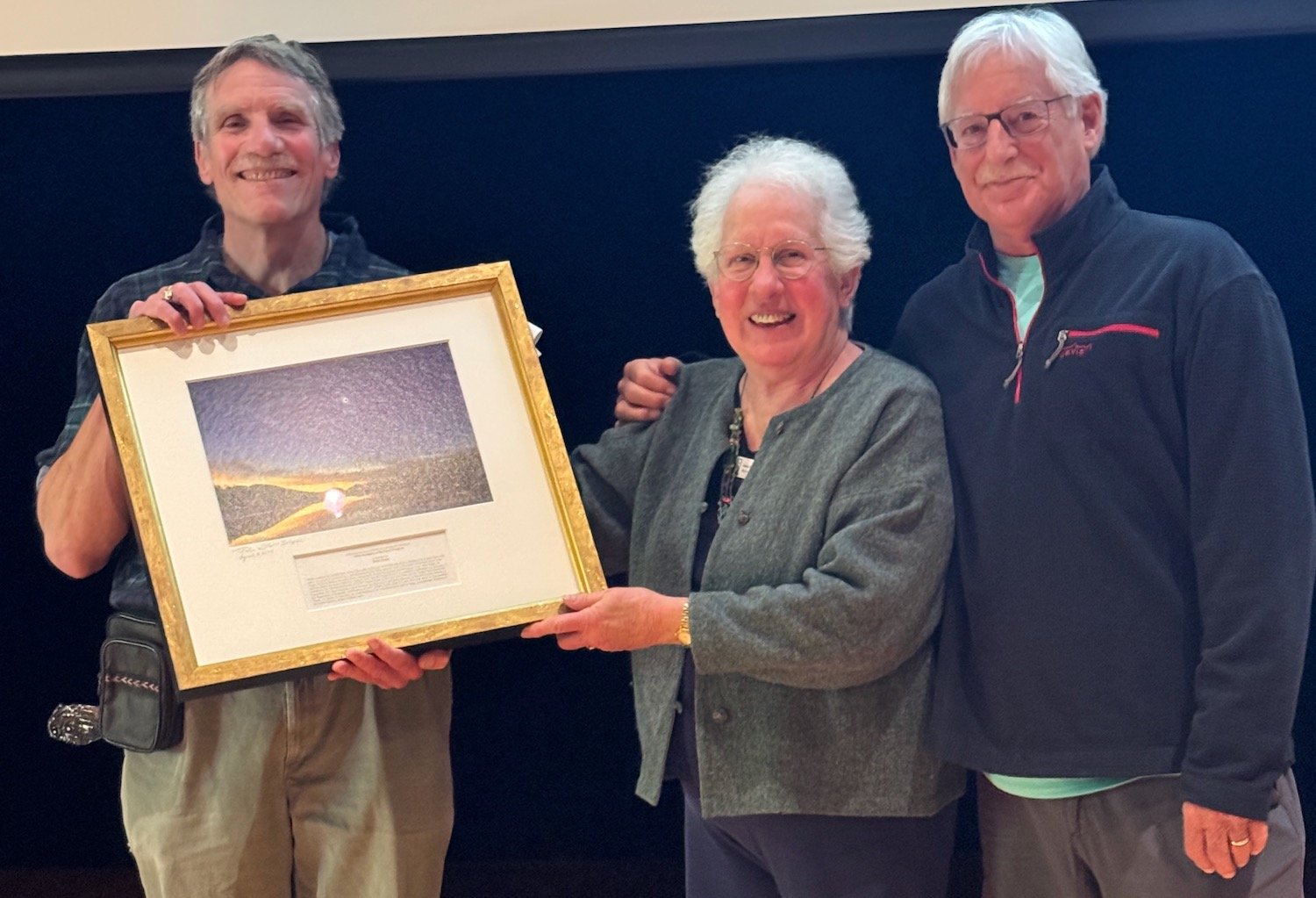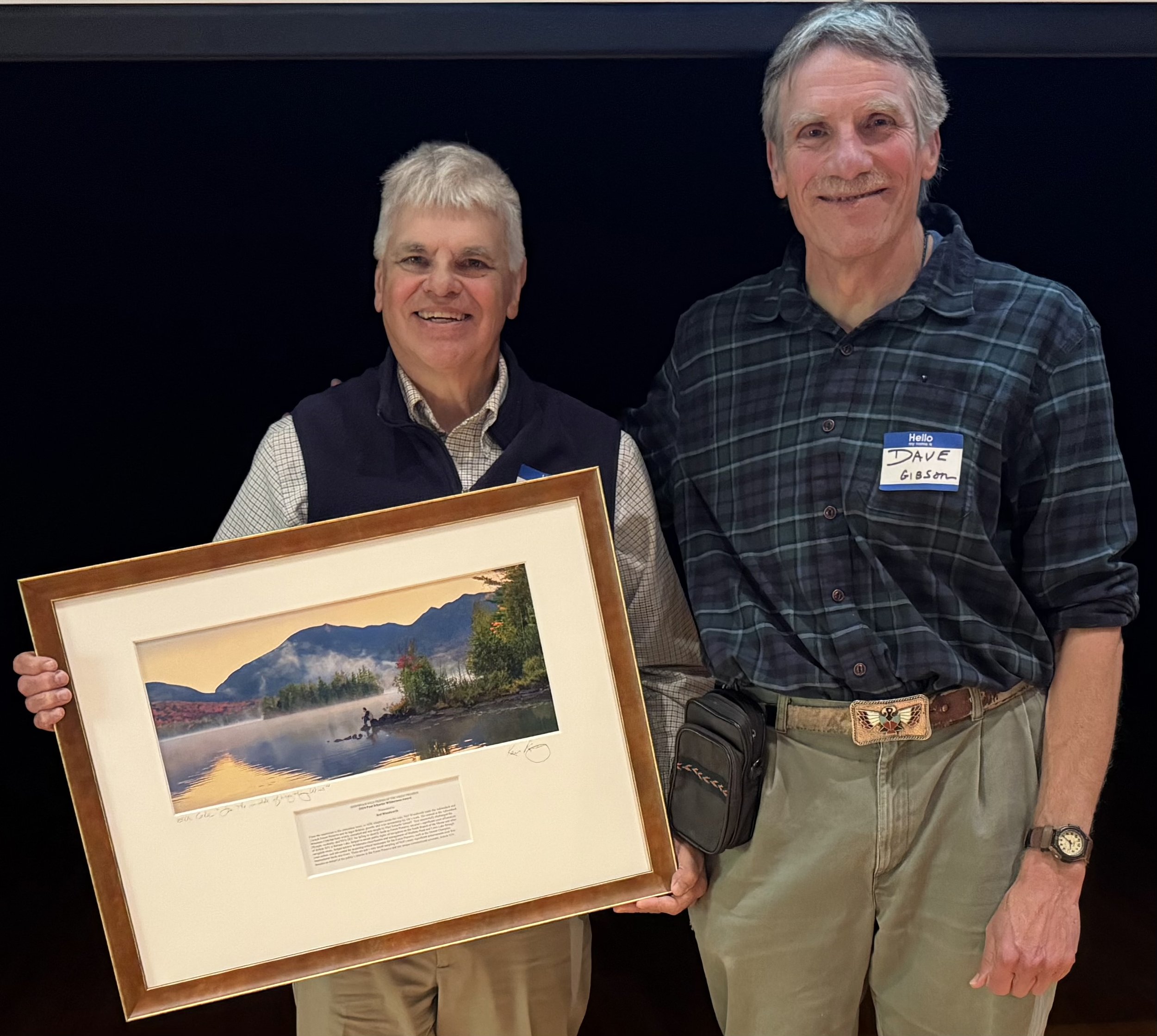Celebrating the ‘Prophetic Call of Wilderness’
Commemorating the 60th anniversary of Congress’s passage of the National Wilderness Preservation Act, Adirondack Wild Managing Partner David Gibson paid tribute to Paul Schaefer and Howard Zahniser. Photo by Ken Rimany
In the wilderness of the Adirondacks, echoes of conservation efforts stretch across time—rooted in the timeless mountains and valleys that have inspired generations of preservationists. For many in the Adirondack community, the Forever Wild clause of New York’s constitution is a familiar legacy, a fundamental bulwark against development that has protected state-owned lands inside the Blue Line since 1894. But fewer know that the Adirondacks also inspired a national and international model for wilderness protection—a story that begins with two remarkable figures: Paul Schaefer and Howard Zahniser. Their collaboration led in 1964 to passage of the National Wilderness Preservation Act.
The 60th anniversary of this achievement was a major focus of the recent annual meeting of Adirondack Wild: Friends of the Forest Preserve, the organization Paul Schaefer launched in 1946 to uphold the Forever Wild principles articulated in Article 14 of the state constitution, which succinctly states:
The lands of the state now owned or here after acquired constituting the forest preserve as now fixed by law shall be forever kept as wild forest lands. They shall not be leased, sold or exchanged, or be taken by any corporation, public or private, nor shall the timber thereon be sold, removed or destroyed.
Legendary Adirondack preservationist John Apperson would open every meeting with a reading of Article 14. That's how David Gibson, Adirondack Wild managing partner, opened this meeting as well.
"Fifty-four words," he said. "Mario Cuomo admired its succinctness."
The partnership Zahniser and Schaefer forged would shape wilderness preservation in ways both immediate and far-reaching, Zahniser’s eight-year campaign for the Wilderness Act was deeply inspired by New York’s Forever Wild clause.
The act, which established the National Wilderness Preservation System, initially protected 9.1 million acres; today, it safeguards 111 million acres from roads, mechanized vehicles, and power equipment. It marked a new phase in American environmental law by granting wilderness areas “legislative designation instead of an agency designation,” as Ed Zahniser put it.
This was a milestone that set national policy on a course of restraint and humility toward natural conditions—a step toward what Aldo Leopold envisioned as a “land ethic,” as we've explored in a series of articles:
Exploring Cabin Country
Both Paul Schaefer and Howard Zahniser drew inspiration from the land about which Schaefer would eloquently write in Adirondack Cabin Country, a collection of short essays published three years before his death in 1996.
An "Environmental Ethic"
"New York's experience convinced my father that the only road to truly preserving wilderness was to do it under federal statute," said Ed Zahniser, Howard's son. "You had to take it out of the hands of the public lands agency managers."
New York's Story in Wilderness Conservation: Parts One and Two
David Gibson describes how Paul Schaefer and Howard Zahniser met in 1946 and immediately teamed up to fight the mega-dams that would have inundated the Moose River Plains.
A Conversation with Ellen Apperson Brown
"Paul Schaefer discovered Apperson during the battles that were going on in 1930 and 1931," says Ellen Apperson Brown, John Apperson's grand-niece.
Helen Chase, Neil Woodworth, and Sara Frankenfeld were honored for their contributions to wilderness preservation. See details below. Photo by Ken Rimany
Zahniser produced 66 drafts of the act over eight years, largely from his Adirondack cabin, where he and Schaefer would discuss strategy on the porch, overlooking Crane Mountain. Between visits to Washington, D.C., Zahniser found solace and inspiration in the Adirondacks’ enduring landscapes, where the simplicity of nature provided clarity amid the complexities of legislation. His goal was to craft a law that not only protected wild lands but also enshrined a broader environmental ethic—a “prophetic call” that would extend across the nation.
David Gibson sees the same spirit guiding Adirondack Wild's current work. From challenging the expansion of marinas that would impact lake ecosystems to pushing for sustainable trail-building practices, the organization remains vigilant.
A recent lawsuit against a developer seeking to quadruple the size of a marina at Fish Creek Pond tested the limits of advocacy. “The developer sued us for defamation, seeking $1 million in damages, but the court upheld our right to speak out,” Gibson said. It was a significant victory for Adirondack Wild and the broader movement to protect public participation in environmental decision-making.
Schaefer’s and Zahniser’s cabins still stand near Eleventh Mountain, silent witnesses to the history of conservation and the ongoing efforts to protect New York’s wild lands. The Wilderness Act, which started as a vision shared on a porch in the Adirondacks, remains a testament to the enduring power of grassroots activism and the belief that, in the words of Leopold, the “boundaries of the community” can be enlarged to include not just people, but all of nature.
Adirondack Wild continues to carry the torch of wilderness preservation, striving to honor the prophetic call that has guided it for nearly 80 years—one that insists on restraint, humility, and a deep respect for the untamed lands that define the Adirondacks.
THE AWARDS
Helen Chase with David Gibson and Ken Rimany, whose photos grace the plaques. Photo by John Eldridge
Champion of the Forest Preserve
Presented to Helen Chase, a resident of Shokan in the Catskill Park, for her years as a planner, communicator, consensus builder and advocate for the crucial watershed values of the public’s Forest Preserve in the Adirondack and Catskill Parks. Helen has chaired the NYS DEC Forest Preserve Advisory Committee and the Catskill Park Centennial Committee. Currently she is an officer with the Catskill Center for Conservation and Development and a board director with Adirondack Wild: Friends of the Forest Preserve.
Sara Frankenfeld
Wild Stewardship Award
Presented to Sara Frankenfield, GIS administrator for the Warren County Department of Planning and Community Development, for helping Warren County to take advantage of the Forest Preserve in Warren County as an asset for heritage tourism. Among many other projects, Sara applies her GIS talents helping, in partnership with Cliff & Redfield Interactive, to create the First Wilderness Story Collaboration to guide outdoor adventure, appreciation, understanding and tourism in Warren County.
Neil Woodworth and David Gibson / Photo by Ken Rimany
Paul Schaefer Wilderness Award
Presented to Neil Woodworth. An Adirondack resident of Wanakena, Neil led the Adirondack Mountain Club as its conservation chair, executive director and legal counsel from the mid-1980s until 2019, defending New York’s “forever wild” state constitution, upholding wilderness principles, validating the public’s rights to paddle navigable rivers and helping to pass legislation protective of New York’s public lands and waters.









